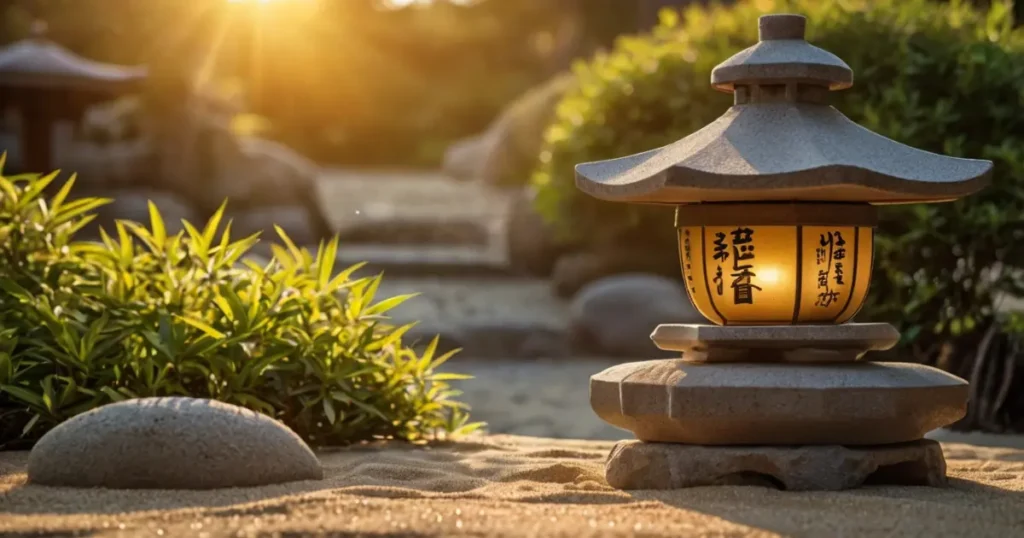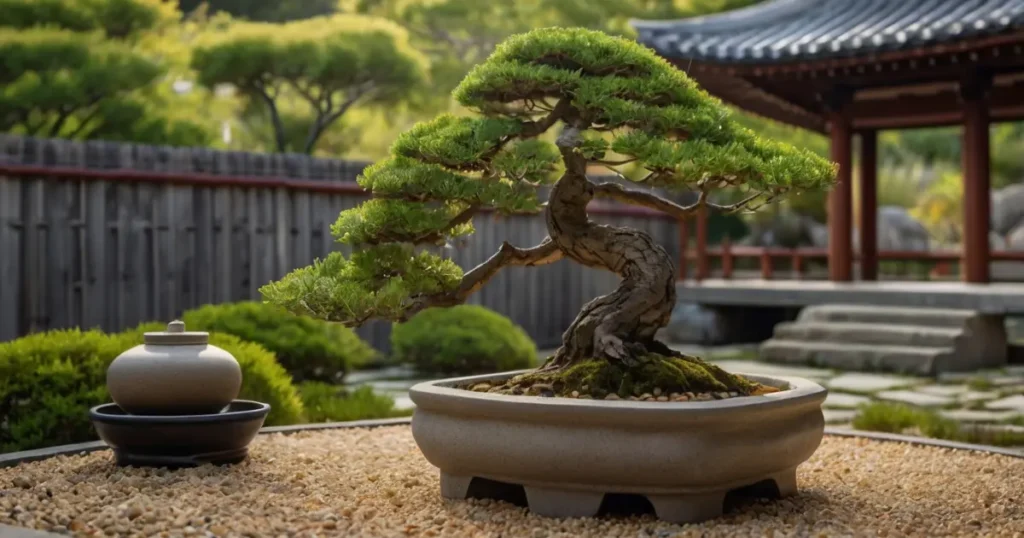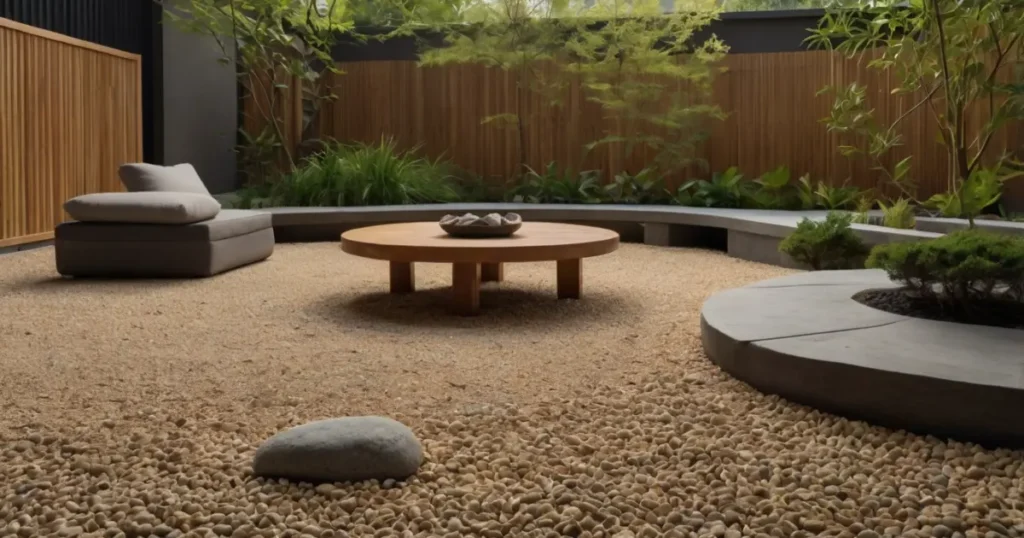Have you ever walked into your backyard and felt more stressed than when you were inside? If so, you’re not alone. My own outdoor space used to be a source of endless to-do lists rather than relaxation. That all changed when I discovered the transformative power of creating a backyard zen garden. These minimalist, Japanese-inspired spaces aren’t just beautiful to look at—they’re purposefully designed to promote mindfulness, reduce anxiety, and create a peaceful retreat right outside your door.
What Exactly Is a Backyard Zen Garden?
A traditional zen garden (also called a Japanese rock garden or “karesansui”) originated in Zen Buddhist temples as spaces for meditation and contemplation. Today’s backyard zen gardens bring these principles home with carefully arranged elements that symbolize larger natural landscapes.
The beauty of a zen garden in backyard spaces is that it can be adapted to any size—from a tiny corner to an expansive yard. What makes them special isn’t their size but their intentional design focused on simplicity and harmony.

Why Your Mind (and Home) Need a Zen Garden
Before diving into the “how,” let’s talk about the “why.” According to Dr. Susan Bartell, environmental psychologist and wellness expert, “Creating dedicated spaces for mindfulness in your immediate environment can significantly reduce cortisol levels and improve overall mental health.“
In my experience, the benefits include:
- A dedicated space for meditation and reflection
- Reduced yard maintenance compared to traditional gardens
- A beautiful focal point that enhances property value
- A natural stress-relief environment just steps from your home
- An outdoor meditation space that encourages daily mindfulness practice
Planning Your Backyard Zen Garden: First Steps
1. Choose the Right Location
The first step in creating your peaceful backyard retreat is selecting the perfect location. I recommend finding a spot that:
- Receives partial sun/shade (especially if you plan to include moss or certain plants)
- Can be viewed from inside your home (to enjoy even during bad weather)
- Feels somewhat secluded from neighbors and street noise
- Has relatively flat terrain (or can be leveled with minimal effort)
2. Determine the Size and Boundaries
When I created my first zen garden in my backyard, I started small—just a 10′ x 10′ area. This allowed me to test concepts before expanding. Consider using:
- Wooden or bamboo fences for traditional boundary markers
- Stone walls for permanent, solid borders
- Ornamental grasses to create natural privacy screens
- Subtle level changes to define the space
3. Create a Simple Sketch
Before purchasing materials, I always recommend creating a rough sketch. Include:
- Overall dimensions
- Placement of major elements (rocks, sand areas, plants)
- Pathways and seating areas
- Focal points and views from different angles
Essential Elements for Your Backyard Zen Garden
1. The Foundation: Sand and Gravel
The foundation of most zen gardens is a bed of carefully chosen gravel and pebbles. According to landscape architect Michael Reynolds of Zen Garden Studio, “The type of aggregate you choose sets the tone for the entire garden. Finer materials create a more formal look, while larger pebbles feel more rustic.“
For my garden, I chose:
- Fine white granite gravel for the main “canvas”
- Medium-sized river pebbles to define edges
- Larger smooth stones for accent areas
Pro tip: Always install landscape fabric underneath to prevent weed growth and keep your materials separate from the soil below.
2. Mastering Stone Selection and Placement
Perhaps the most important element in any backyard zen garden is the placement of stones and rocks. In traditional design, stones represent mountains rising from the sea (represented by sand or gravel).
Key principles I learned through trial and error:
- Use odd numbers of stones (groups of 3, 5, or 7 work best)
- Vary sizes dramatically (include at least one large “statement” stone)
- Bury approximately 1/3 of each stone for a natural appearance
- Create asymmetrical arrangements that lead the eye through the garden
- Consider the natural grain and character of each stone
3. Incorporating Plants Thoughtfully
While traditional zen gardens were often plant-free, modern interpretations usually include carefully selected greenery. Landscape designer Jennifer Liu recommends: “Choose plants that maintain their form throughout the seasons and require minimal maintenance to preserve the garden’s contemplative nature.“
Some excellent choices for your backyard zen garden include:
- Moss and bamboo plants for traditional Japanese elements
- Japanese maples for elegant structure and seasonal color
- Ornamental grasses that move gracefully in the breeze
- Bonsai trees for Zen gardens to create miniature landscapes
- Evergreen shrubs pruned into simple, rounded forms
4. Water Features: Real or Symbolic
Water brings movement and sound to your peaceful backyard retreat. You can incorporate it either literally or symbolically:
- Small cascading fountains create gentle, meditative sounds
- Still, reflection pools mirror the sky and surrounding elements
- Dry “stream beds” of polished stones symbolize water’s path
- Rain chains direct water during storms, creating temporary water features
I opted for a small bubbling stone in my garden, which provides the gentle sound of water features for calm without the maintenance of a larger pond.

Sand Raking: The Meditative Heart of Zen Gardens
One of the most distinctive elements of any zen garden is the patterns raked into sand or fine gravel. These patterns typically represent water, waves, or ripples and create a mesmerizing visual effect.
Basic Sand Raking Techniques:
- Straight lines: Begin with simple parallel lines across your sand area
- Circular patterns: Create concentric circles around stones or features
- Wave patterns: Develop gentle curves reminiscent of ocean waves
- Combination patterns: Blend different techniques in separate areas
The tool matters considerably. I invested in a traditional wooden rake with prongs spaced about 1″ apart, which creates the perfect texture in my fine gravel. The process of creating these patterns becomes a mindful outdoor living practice in itself—I find myself raking fresh patterns several times a week as a form of moving meditation.
Lighting Your Zen Space
Thoughtful lighting extends the enjoyment of your backyard zen garden into the evening hours. Traditional garden lanterns (Ishidoro) provide both illumination and authentic decorative elements.
Consider these lighting approaches:
- Stone lanterns placed at key points or entrances
- Subtle path lighting along stone walkways
- Uplighting on signature trees or stone arrangements
- Solar-powered options for sustainability
My garden features three small solar lanterns that charge during the day and emit a soft glow at night, creating magical evening shadows across the raked sand patterns.
Creating Pathways and Transitions
Natural stone pathways serve both practical and aesthetic purposes in your zen garden in backyard areas. They:
- Define how people move through and experience the space
- Create purposeful journeys with reveals and discoveries
- Protect sand and gravel areas from footprints
- Serve as boundaries between different garden zones
For my pathways, I chose irregular flagstones set directly into the soil with small creeping thyme growing between them. This creates a living path that releases a pleasant aroma when walked upon.

Mindful Seating: Where to Contemplate
Every outdoor meditation space needs at least one carefully considered spot for sitting and contemplation. The best minimalist seating ideas don’t dominate the space but blend harmoniously with it.
Options to consider:
- Simple wooden benches without backs
- Large, flat “sitting stones” positioned strategically
- Bamboo mats that can be placed when needed
- Low platforms with weather-resistant cushions
My personal experience: I placed a simple cedar bench at the edge of my garden rather than in the center. This allows me to observe the entire composition while feeling like I’m part of the scene rather than disrupting it.
Zen Garden Maintenance: Keeping the Peace
One of the joys of a backyard zen garden is its relatively low maintenance compared to traditional gardens. However, some regular care ensures your stress-relief garden remains peaceful rather than becoming another source of work.
My maintenance routine includes:
- Weekly raking of sand/gravel areas (more often if leaves fall or patterns are disturbed)
- Monthly weeding of any volunteers that appear (usually minimal thanks to landscape fabric)
- Seasonal pruning of plants to maintain their clean forms
- Occasional refreshing of gravel or sand as needed (usually every 2-3 years)
Real-Life Transformation: A Case Study
When Mark and Jenna Halstead moved into their suburban home, their backyard was a neglected lawn with patchy grass and little character. “We wanted something low-maintenance but meaningful,” Jenna explains. “Something that would make us want to spend time outdoors.“
Working with a budget of $2,500, they transformed a 20′ x 15′ section of their yard into a peaceful backyard retreat over three weekends. Their approach:
- Removed existing sod and installed landscape fabric
- Created a border using reclaimed wooden railroad ties
- Added 2 tons of white granite gravel as the base
- Installed three large boulders sourced from a local quarry
- Planted two Japanese maples and several clumps of black mondo grass
- Added a simple wooden bench and three solar lanterns
“The transformation was incredible,” Mark shares. “We use the space almost daily now—morning coffee, evening unwinding, weekend meditation. It’s become the heart of our home.“

Expert Corner: Words from a Zen Garden Master
I spoke with James Natori, a third-generation Japanese garden designer with over 30 years of experience creating zen gardens across the country. His most important advice:
“The Western mind often wants to fill space completely. The Eastern approach values empty space—what we call ‘ma’—just as highly as the elements themselves. A truly successful backyard zen garden has a perfect balance between what is present and what is absent.“
Natori recommends that first-time zen garden creators begin with a 70/30 ratio: 70% open space (sand, gravel) to 30% elements (stones, plants, features). “This creates room for the eye and mind to rest,” he explains. “Over time, you can adjust this balance as your understanding deepens.“
My Personal Journey: Lessons Learned
When I created my first backyard zen garden five years ago, I made several mistakes:
- I chose stones that were too small and uniform, creating a cluttered look
- I initially included too many plant varieties, which felt chaotic
- I positioned my garden too far from the house, making it feel disconnected
Through trial and error, I’ve learned that simplicity truly is the foundation of zen garden design. Each element should earn its place, and editing is often more important than adding.
Budget-Friendly Zen: Creating Calm Without Breaking the Bank
Creating a stress-relief garden doesn’t have to be expensive. Here’s how I would approach a zen garden on three different budgets:
Starter Zen ($250-500)
- Convert a small area using landscape fabric and inexpensive gravel
- Add 3-5 significant stones (often available free from construction sites or landscaping companies)
- Include a simple wooden bench and one Japanese-inspired lantern
- Focus on one specimen plant as a focal point
Mid-Range Zen ($1,000-2,000)
- Expand the area and use higher-quality materials
- Invest in several larger, character-filled stones
- Add a small water feature
- Include multiple specimen plants and traditional elements
- Consider professional hardscaping for pathways
Dream Zen ($3,000+)
- Consider hiring a consultant for the initial design
- Use premium materials throughout
- Include authentic stone lanterns and water features
- Create multiple “rooms” or experiences within the garden
- Add custom-built seating and structures

Adapting Zen Principles for Your Climate
One challenge I faced in creating my garden was adapting traditional Japanese elements to my local climate. Here’s how to make adjustments for different regions:
Hot, Dry Climates
- Use more stone and gravel elements
- Consider drought-tolerant alternatives to traditional plants
- Create shade with structures rather than trees that need water
- Focus on morning and evening use patterns
Cold, Snowy Regions
- Choose stones and features that create winter interest
- Select evergreen plants for year-round structure
- Consider how snow will interact with and enhance your design
- Install garden lighting for shorter winter days
Wet, Rainy Areas
- Ensure proper drainage beneath gravel areas
- Select moisture-loving alternatives to traditional zen plants
- Create covered seating areas for year-round enjoyment
- Emphasize moss as a natural, authentic element
From Zen Garden to Life Philosophy
What began as my simple backyard zen garden project gradually evolved into a daily practice of mindfulness. The principles that guide garden design—simplicity, intention, harmony, and respect for natural processes—have influenced how I approach other aspects of my life.
As Lisa Takahashi writes in The Stillness Chronicles: A Zen Garden Diary, “Creating and maintaining a zen garden isn’t just about changing your yard—it’s about changing your relationship with time, space, and your own thoughts.“
Conclusion: Your Zen Journey Awaits
Creating a backyard zen garden is more than a landscaping project—it’s an invitation to slow down and reconnect with both nature and yourself. Whether you start with a small corner or transform your entire yard, the process itself embodies the mindfulness these spaces are designed to encourage.
I hope this guide helps you create your own peaceful backyard retreat—a space where you can step away from chaos and into calm, one mindful moment at a time. Remember that your garden will evolve over seasons and years, becoming more meaningful as it ages and as your understanding of zen principles deepens.

Additional Resources
Academics & Research
- “Japanese Garden Principles & Psychology of Space” – Research from the Journal of Environmental Psychology.
- “The Science Behind Meditative Landscapes” – From Harvard University.
- “How a Zen Garden Benefits Your Mind and Body” – By Melecio Martin G. Arranz IV
Other Related Websites
- The Japanese Garden Society
- American Society of Landscape Architects (ASLA)
- National Garden Association
Books for Reference
- “Zen Gardens: The Complete Works of Shunmyo Masuno” – by Mira Locher
- “The Art of the Japanese Garden” – by David Young, Michiko Young, Tan Hong Yew
- “Sacred Gardens and Landscapes” – edited by Michel Conan
Also read – Shades of Green: A Comprehensive Guide to 9 Sustainable Practices for a Lush Green Landscape Garden
Frequently Asked Questions (FAQs)
Q.1 – How can I incorporate the five elements of nature (Earth, Water, Fire, Air, and Space) into my backyard Zen garden?
A truly balanced Zen garden integrates the five elements of nature to create harmony:
- Earth – Use natural stones, gravel, or boulders to provide grounding energy.
- Water – Introduce a small pond, fountain, or dry sand riverbed to symbolize the flow of life.
- Fire – Place a stone lantern (Ishidoro) with soft lighting or a fire bowl to bring warmth and transformation.
- Air – Design open spaces that allow the wind to flow freely, enhancing a sense of movement and mindfulness.
- Space – Avoid clutter by maintaining minimalism and open areas, allowing the mind to rest in stillness.
By carefully integrating these elements, you create a holistic and balanced Zen space that enhances relaxation.
Q.2 – What are some unconventional but effective sound elements I can add to my backyard Zen garden?
Sound plays a crucial role in deepening the meditative experience of a Zen garden. Beyond water features, consider these unique auditory elements:
- Wind harps or Aeolian harps – These stringed instruments produce natural, soothing melodies as the wind passes through.
- Resonant stone chimes – Unlike typical metal wind chimes, stones or bamboo create soft, organic sounds.
- Rustling bamboo – Planting tall bamboo generates a calming rustling effect with every breeze.
- Soft gravel pathways – Walking on finely crushed gravel produces a rhythmic, meditative crunching sound.
- Hidden speakers with nature sounds – If natural sounds are scarce, play subtle temple bells or forest ambiance for an immersive experience.
These sounds can enhance mindfulness and deepen relaxation, making your Zen garden truly unique.
Q.3 – How can I use my backyard Zen garden as a tool for creative thinking and problem-solving?
A Zen garden isn’t just for relaxation—it can be a powerful tool for boosting creativity and problem-solving. Here’s how:
- Rake sand mindfully – While raking, focus on a problem you’re trying to solve. The repetitive motion and patterns stimulate deep thinking and new perspectives.
- Stone placement as a metaphor – Assign different stones to represent challenges or goals and rearrange them to explore solutions visually.
- Journaling in the garden – Use a notebook to write down thoughts while sitting in the tranquil space. The stillness often leads to breakthrough ideas.
- Walking meditation – Slowly walk barefoot on gravel paths or stone pathways, allowing new ideas to emerge naturally.
Zen gardens offer a meditative approach to thinking, which can help unlock creativity and clarity in life.
Q.4 – What are some Zen-inspired nighttime lighting techniques to enhance the atmosphere?
A backyard Zen garden transforms at night with the right lighting. Instead of generic outdoor lighting, try these Zen-inspired techniques:
- Moonlighting (Tsukimi-dōrō style) – Place soft, downward-facing lights in trees or tall structures to mimic natural moonlight.
- Shadow play – Position lanterns behind rocks or plants to cast dynamic, moving shadows for a mystical effect.
- Floating candles or lanterns – If you have a water feature, use floating lanterns or candles for a serene glow.
- Subtle ground lighting – Small recessed lights along pathways keep the ambiance calm while ensuring visibility.
- Fire bowls or torches – A controlled fire element adds warmth and a mesmerizing flickering effect.
Lighting can create a magical and deeply tranquil atmosphere, extending the experience of your Zen garden into the night.
Q.5 – Can I combine my Zen garden with other cultural influences for a unique fusion style?
Absolutely! While traditional Zen gardens originate from Japan, you can blend influences from other cultures to create a unique fusion Zen garden:
- Japanese + Chinese – Integrate feng shui principles, such as balancing yin and yang elements, while keeping a Zen minimalist approach.
- Zen + Scandinavian (Japandi style) – Combine Japanese Zen simplicity with Scandinavian warmth, using natural wood, soft lighting, and cozy outdoor seating.
- Zen + Mediterranean – Use white pebbles, olive trees, and terracotta pots while keeping Zen sand raking and stone placement.
- Zen + Indian – Introduce lotus ponds, small Buddha statues, and aromatic plants like jasmine and sandalwood.
- Zen + Desert Style – Use succulents, cacti, and fine sand patterns for a minimalist yet striking desert Zen vibe.
A fusion Zen garden allows you to infuse personal meaning while maintaining harmony and mindfulness.
Have you created a zen-inspired space in your home or garden? I’d love to hear about your experience in the comments below!
*Images used in this blog post article are for illustrative purposes only. We do not possess any copyrights to these images unless explicitly mentioned.

Nikhil Shukla
About The Author
Nikhil, with a background in Technology, is deeply passionate about Interior Design and Home Décor. At Cherry Hills Home Living, he channels this passion into creating inviting and stylish living spaces. With a unique blend of analytical thinking and creative flair, Nikhil offers innovative ideas, practical tips, and inspiring guidance to help others transform their homes into cozy retreats.
I consider something truly interesting about your blog so I saved to favorites.
Thank you!
So much value packed into one post!
Thank you so much! I am really glad you found the post so valuable! Your support means a lot and keeps me motivated to create more.